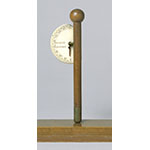Henley quadrant electrometer signed "Nairne London." Comprises a boxwood stem with a brass collar and a short brass rod for insertion in the prime conductor of an electrical machine. When the instrument is charged, the light index, terminating in a light pith or cork ball, is repelled by the stem and moves across the semicircular ivory graduated scale. The device was invented in 1770 by William Henley to measure electrical "tension," i.e., voltage. It is the first single-pendulum repulsion electrometer. Provenance: Lorraine collections.
Provenance
Inventors
Makers
Typology
Context
Dictionary
In depth










